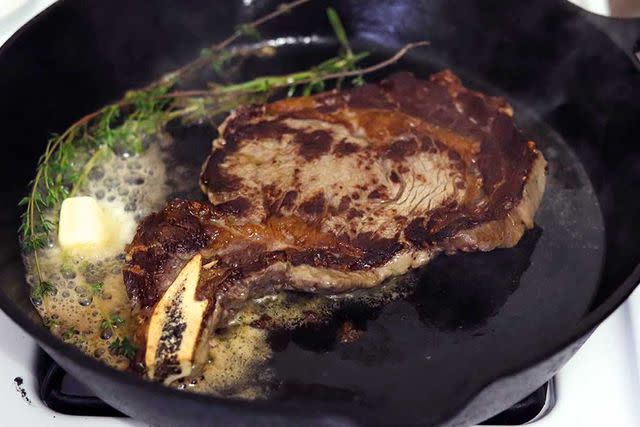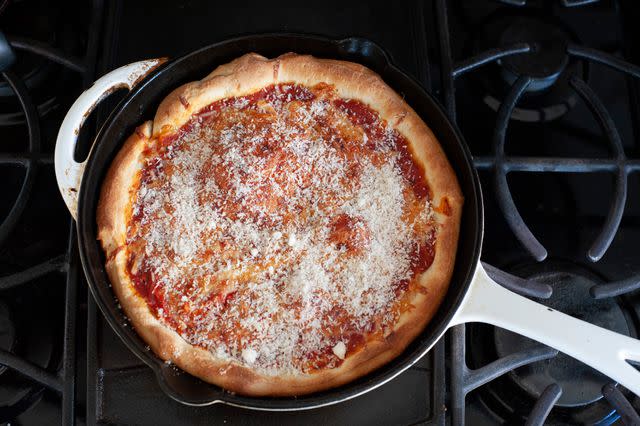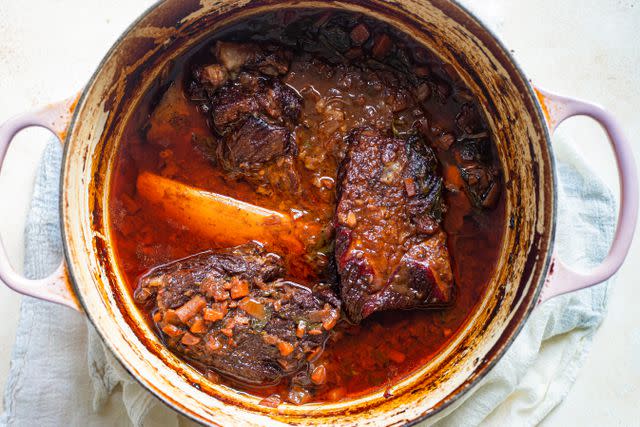How not to ruin your nonstick pan.

Simply Recipes / Sally Vargas
I resisted nonstick pans for years. Erroneously, I assumed nonstick was inferior, that cast iron was king, and that serious cooking was done on stainless steel. Did I just forget that eggs existed? Perhaps.
A few years ago, a nonstick pan was at the top of my kitchen wish list, and I find myself reaching for my nonstick pan when I'm making pancakes, sizzling slices of halloumi cheese—my current favorite way to bulk up a salad—and any time I want to heat something slow and gently that doesn't require high heat.
Nonstick pans do exactly what their name implies: they allow you to cook without food sticking to the surface due to a protective coating, usually made from polytetrafluoroethylene (PTFE, commonly known as Teflon) but sometimes made from other materials like ceramic. In general, as you apply more and more heat, the protective coating breaks down, and some foods react or cook differently on nonstick than other surfaces.
Like most kitchen tools, nonstick pans serve a purpose: their coating ensures that food doesn't get stuck to the surface, but that also means they're less-than-ideal for specific recipes and cooking techniques. Here are the eight things you should never cook on your nonstick pans.
Read More: Is It Safe To Use Scratched Nonstick Pans? Here’s What Experts Say

Simply Recipes / Aaron Hutcherson
1. Steak (And Other Meat You Want to Brown)
Technically, you could cook a steak or brown a piece of meat in nonstick versus cast iron or stainless, but it'd be like using a fork to eat soup: it's the wrong tool for the job. A well-seared piece of meat requires hot heat, something most nonstick pans cannot tolerate due to their coating—that's why you should not throw them in the dishwasher, although I generally do hand wash all my skillets, nonstick and stainless.
I read some articles suggesting you can use nonstick to brown meat, but most came from nonstick pan manufacturers. While certainly possible, just because it's doable doesn't mean it's ideal—I still think you'll get the best sear from a ripping hot cast iron or stainless steel pan.
2. For That Matter, Vegetables You Want To Get Color On
Many recipes call for high heat when cooking vegetables—throwing them in a hot skillet makes the vegetables crunchy and crispy on the outside. Like meat, vegetables require hot temperatures to pick up some browning, which is better done on stainless steel.
If browning vegetables seems new, try it out! Vegetables that fall into the brassica family (think cabbage, broccoli, and Brussels sprouts) take really well to some browning—even charring!
3. Tomato Sauce
Acidic foods like tomatoes can break down the protective coating of your nonstick pan, so recipes like tomato sauce should be made in a different type of skillet. Also, avoid foods with citrus or wine.

Simply Recipes / Alison Bickel
4. Broiled Anything
While you can put certain nonstick pans in the oven if they don't have a plastic-coated handle, which is ideal for dishes like frittatas, many nonstick pans have a maximum temperature, usually between 350 to 500°F.
The broiler setting on your oven is all about hot, high, and direct heat. While some ovens have a range of temperatures you can select, the choices are ambiguous (low versus high instead of a specific temperature setting), so you don't know what temperature you're exposing your pan to.
5. Pan Sauces
One of the things that makes a pan sauce—or a sauce you put together usually after searing meat—delicious is fond, or the brown bits stuck to the bottom of the pan. Fond won't happen on a nonstick, so you won't get as much flavor in the pan sauce from those caramelized bits, which you need for dishes like Steak Diane.
6. Browning Butter
Technically, you can brown butter in a nonstick pan—but it won't be easy. Browning butter is the process of heating butter so that the milk solids start to get toasty and nutty, giving the butter a deeper flavor.
The cues you'll need to assess what stage the butter is in are visual: you'll see the butter go from yellow to brown or even dark brown if you let the butter go too far and the milk solids burn, and most nonstick pans have a dark gray or black coating. It's much easier to brown butter in a light-colored pan, like stainless steel.

Simply Recipes / Karishma Pradhan
7. Braises
A braise starts with browning a piece of meat—not ideal on a nonstick pan—and then adding liquid to cook slowly. A nonstick pan is the wrong shape for a braise—I'd recommend something with tall sides like a Dutch oven.
Furthermore, if you want to reduce and deglaze the pan once the meat is finished cooking, you won't get as much flavor from brown bits sticking to the bottom.
8. Nothing At All
Many recipes ask you to preheat your pan; for many cooks, that means putting a pan on the stove and letting it get hot before adding fat like butter or oil. Preheating a nonstick pan without anything in the pan can break down the coating. Before throwing on the stovetop to preheat, make sure there's a little bit of oil or butter hanging out in the pan.
https://news.google.com/rss/articles/CBMiTGh0dHBzOi8vd3d3LnlhaG9vLmNvbS9saWZlc3R5bGUvOC1mb29kcy1zdG9wLWNvb2tpbmctbm9uc3RpY2stMTUzMDAwNTA2Lmh0bWzSAVRodHRwczovL3d3dy55YWhvby5jb20vYW1waHRtbC9saWZlc3R5bGUvOC1mb29kcy1zdG9wLWNvb2tpbmctbm9uc3RpY2stMTUzMDAwNTA2Lmh0bWw?oc=5
2023-06-24 15:30:00Z
CBMiTGh0dHBzOi8vd3d3LnlhaG9vLmNvbS9saWZlc3R5bGUvOC1mb29kcy1zdG9wLWNvb2tpbmctbm9uc3RpY2stMTUzMDAwNTA2Lmh0bWzSAVRodHRwczovL3d3dy55YWhvby5jb20vYW1waHRtbC9saWZlc3R5bGUvOC1mb29kcy1zdG9wLWNvb2tpbmctbm9uc3RpY2stMTUzMDAwNTA2Lmh0bWw
Bagikan Berita Ini

















0 Response to "8 Foods You Should Stop Cooking in Your Nonstick Pan - Yahoo Life"
Post a Comment